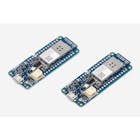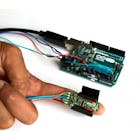Smart Breathing Detection Integrated with Pulse Oximetry © MIT
DESCRIPTION
Background
Airborne is a transmission that delivers aerosols or droplets (droplets) that are very small. Aerosols are also known as microdroplets. The size is less than 5 micrometers. While droplets are usually larger than 5 micrometers. Because it is small and lightweight, the aerosol carrying the SARS-CoV-2 coronavirus can survive floating in the air for several hours. In addition, this aerosol can also drift quite far. Studies in the US call the SARS-CoV-2 coronavirus can live on aerosols for up to four hours. While other studies (not yet peer-reviewed) say it can last 16 hours (https://www.cnbcindonesia.com/).
Research shows coronaviruses that are artificially sprayed can stay alive in the air for at least three hours. But the scientists stressed that the experiment was conducted in a laboratory, which is different from real-life conditions where the results can vary. Cases of coronavirus, called 'super spreading', have strengthened the suspicion that airborne contamination is a possibility. In the city of Mount Vernon in Washington, USA, one person is suspected of infecting at least 45 other people, who have sung with him in the same choir (https://www.bbc.com/indonesia/majalah-53344413).
But WHO says more research is needed to further strengthen the evidence. At present, the main spread method, still believed through droplets and fomites, refers to objects held by the patient. Airborne transmission, the WHO says, can occur if the virus-carrying droplets produce "very small particles in the air by vaporizing" or "the result of talk in exhaled air".
Carbon dioxide (CO2) is a byproduct of combustion, as well as a result of the metabolic process in living organisms. Because carbon dioxide is a result of human metabolism, concentrations within a building often are used to indicate whether adequate fresh air is being supplied to space. Moderate to high levels of carbon dioxide can cause headaches and fatigue, and higher concentrations can produce nausea, dizziness, and vomiting. Loss of consciousness can occur at extremely high concentrations. At room temperature, carbon dioxide is a colorless, odorless, faintly acidic-tasting, non-flammable gas. Carbon dioxide is a byproduct of normal cell function and is removed from the body via the lungs in the exhaled air. Carbon dioxide is also produced when fossil fuels are burned(https://ohsonline.com/articles/2016/04/01/carbon-dioxide-detection-and-indoor-air-quality-control.aspx).
Solution
One of the largest sources of indoor carbon dioxide is actually our bodies. As you breathe, each one of your body’s cells takes in oxygen to complete a process called cellular respiration. During this series of chemical reactions, your body produces carbon dioxide, which it releases it when you exhale. Typically this carbon dioxide would disperse into the air, but in closed rooms and homes the CO2 has nowhere to go.
Human respiration emits volatile gas, so detecting volatile gas of human breath and measuring body temperature is the main suggestion for the prevention of contracting Covid-19. Detecting volatile organic compounds (VOC) through exhaled breath is to find out respiratory diseases.
We then develop “smart breathing detection integrated with pulse oximeter” which is called AQTech. It detects carbon dioxide concentration and the total volatile organic compounds (VOCs) from human respiration and detects blood oxygen levels using a pulse oximeter. The data of pulse oximetry and volatile gas coming out of human breath can be correlated to determine symptoms of respiratory disease through analytics.
A normal blood oxygen reading would be between 95 and 100 percent, Anything under 90 is considered unhealthy. While indicated coronavirus patients with measurements as low as 50 percent. When oxygen levels sink this far, patients have much more apparent trouble breathing. Instead, these patients were often coming into the ER only after recently noticing a shortness of breath and having been sick with symptoms like fever, cough, upset stomach, and fatigue for a week. With COVID-19, the lungs initially remain “compliant, ” meaning not yet stiff or heavy with fluid, so they’re able to get rid of carbon dioxide even as their ability to provide oxygen to the body becomes impaired. A buildup of carbon dioxide would cause patients to become lethargic or unconscious. The oxygen depletion may not be apparent immediately because the virus attacks the lungs in such a way that the patient gradually gets less and less oxygen over time (https://www.everydayhealth.com/coronavirus/can-a-pulse-oximeter-save-your-life-if-you-have-covid-19/).
Then the data could be the basis for further treatment and/or practices to improve the detection system through exhaled breathing. AQTech technology is based on the Internet of Things (IoT) integrated with a pulse oximetry sensor to measure heart rate, blood oxygen level and to detect exhaled breathing volatile organic compounds (VOCs) and CO2 concentration for detecting the infection of respiratory disease.
The data could be set, as well as the monitoring results are also directly connected and actually stored on the influxdb on IoT Gateway. From IoT gateway, the IoT system is used to send data of heart rate, oxygen level, carbon dioxide, and volatile organic compounds to the cloud for analytics in real-time. The technology in this project is to help detect the infection of respiratory disease through analytics VOCs and CO2 concentration from exhaled breathing and measuring blood oxygen level.
A network sensor system consisting of Arduino MKR1010, MAX30100 pulse oximetry sensor, and CSS811 air quality sensors is used to measure carbon dioxide and total volatile organic compounds from exhaled breathing. Data transmission used in a communication protocol is Message Queuing Telemetry Transport (MQTT) in which sensors are connected to an IoT gateway (BalenaFin board) programmed using NodeRED. By using the MQTT protocol, communication between the microcontroller, gateway and mobile apps or computers can be made integrated.
Data of measurement consist of 4 values connected to the Node-RED, cloud, local database using influxdb, visualization, and computational modeling. Sensor data stored on the database can be used for the visualization process in real-time.
1. Arduino IDE
2. Arduino MKR1010
3. CSS811 air quality sensors
4. MAX30100 Pulse Oximetry sensor
5. BalenaFin
Background
Airborne is a transmission that delivers aerosols or droplets (droplets) that are very small. Aerosols are also known as microdroplets. The size is less than 5 micrometers. While droplets are usually larger than 5 micrometers. Because it is small and lightweight, the aerosol carrying the SARS-CoV-2 coronavirus can survive floating in the air for several hours. In addition, this aerosol can also drift quite far. Studies in the US call the SARS-CoV-2 coronavirus can live on aerosols for up to four hours. While other studies (not yet peer-reviewed) say it can last 16 hours (https://www.cnbcindonesia.com/).
Research shows coronaviruses that are artificially sprayed can stay alive in the air for at least three hours. But the scientists stressed that the experiment was conducted in a laboratory, which is different from real-life conditions where the results can vary. Cases of coronavirus, called 'super spreading', have strengthened the suspicion that airborne contamination is a possibility. In the city of Mount Vernon in Washington, USA, one person is suspected of infecting at least 45 other people, who have sung with him in the same choir (https://www.bbc.com/indonesia/majalah-53344413).
But WHO says more research is needed to further strengthen the evidence. At present, the main spread method, still believed through droplets and fomites, refers to objects held by the patient. Airborne transmission, the WHO says, can occur if the virus-carrying droplets produce "very small particles in the air by vaporizing" or "the result of talk in exhaled air".
Carbon dioxide (CO2) is a byproduct of combustion, as well as a result of the metabolic process in living organisms. Because carbon dioxide is a result of human metabolism, concentrations within a building often are used to indicate whether adequate fresh air is being supplied to space. Moderate to high levels of carbon dioxide can cause headaches and fatigue, and higher concentrations can produce nausea, dizziness, and vomiting. Loss of consciousness can occur at extremely high concentrations. At room temperature, carbon dioxide is a colorless, odorless, faintly acidic-tasting, non-flammable gas. Carbon dioxide is a byproduct of normal cell function and is removed from the body via the lungs in the exhaled air. Carbon dioxide is also produced when fossil fuels are burned(https://ohsonline.com/articles/2016/04/01/carbon-dioxide-detection-and-indoor-air-quality-control.aspx).
Solution
One of the largest sources of indoor carbon dioxide is actually our bodies. As you breathe, each one of your body’s cells takes in oxygen to complete a process called cellular respiration. During this series of chemical reactions, your body produces carbon dioxide, which it releases it when you exhale. Typically this carbon dioxide would disperse into the air, but in closed rooms and homes the CO2 has nowhere to go.
Human respiration emits volatile gas, so detecting volatile gas of human breath and measuring body temperature is the main suggestion for the prevention of contracting Covid-19. Detecting volatile organic compounds (VOC) through exhaled breath is to find out respiratory diseases.
We then develop “smart breathing detection integrated with pulse oximeter” which is called AQTech. It detects carbon dioxide concentration and the total volatile organic compounds (VOCs) from human respiration and detects blood oxygen levels using a pulse oximeter. The data of pulse oximetry and volatile gas coming out of human breath can be correlated to determine symptoms of respiratory disease through analytics.
A normal blood oxygen reading would be between 95 and 100 percent, Anything under 90 is considered unhealthy. While indicated coronavirus patients with measurements as low as 50 percent. When oxygen levels sink this far, patients have much more apparent trouble breathing. Instead, these patients were often coming into the ER only after recently noticing a shortness of breath and having been sick with symptoms like fever, cough, upset stomach, and fatigue for a week. With COVID-19, the lungs initially remain “compliant, ” meaning not yet stiff or heavy with fluid, so they’re able to get rid of carbon dioxide even as their ability to provide oxygen to the body becomes impaired. A buildup of carbon dioxide would cause patients to become lethargic or unconscious. The oxygen depletion may not be apparent immediately because the virus attacks the lungs in such a way that the patient gradually gets less and less oxygen over time (https://www.everydayhealth.com/coronavirus/can-a-pulse-oximeter-save-your-life-if-you-have-covid-19/).
Then the data could be the basis for further treatment and/or practices to improve the detection system through exhaled breathing. AQTech technology is based on the Internet of Things (IoT) integrated with a pulse oximetry sensor to measure heart rate, blood oxygen level and to detect exhaled breathing volatile organic compounds (VOCs) and CO2 concentration for detecting the infection of respiratory disease.
The data could be set, as well as the monitoring results are also directly connected and actually stored on the influxdb on IoT Gateway. From IoT gateway, the IoT system is used to send data of heart rate, oxygen level, carbon dioxide, and volatile organic compounds to the cloud for analytics in real-time. The technology in this project is to help detect the infection of respiratory disease through analytics VOCs and CO2 concentration from exhaled breathing and measuring blood oxygen level.
A network sensor system consisting of Arduino MKR1010, MAX30100 pulse oximetry sensor, and CSS811 air quality sensors is used to measure carbon dioxide and total volatile organic compounds from exhaled breathing. Data transmission used in a communication protocol is Message Queuing Telemetry Transport (MQTT) in which sensors are connected to an IoT gateway (BalenaFin board) programmed using NodeRED. By using the MQTT protocol, communication between the microcontroller, gateway and mobile apps or computers can be made integrated.
Data of measurement consist of 4 values connected to the Node-RED, cloud, local database using influxdb, visualization, and computational modeling. Sensor data stored on the database can be used for the visualization process in real-time.
1. Arduino IDE
2. Arduino MKR1010
3. CSS811 air quality sensors
4. MAX30100 Pulse Oximetry sensor
5. BalenaFin


















